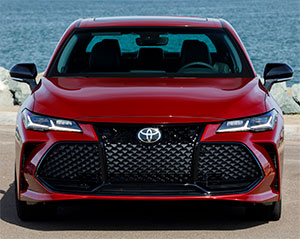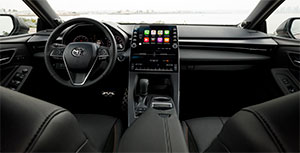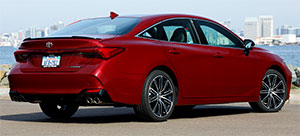2019 Toyota Avalon
It wasn’t that long ago when big sedans were the pinnacle of an automaker’s line up. But times change… and as we all know… SUV’s and crossovers now rule the road. But Toyota for one hasn’t given up on their flagship four-door Avalon… And with an all new design they’re also aiming to attract new buyers that haven’t got silver in their hair.
Now in its 5th generation, the 2019 Toyota Avalon is indeed facing head winds, and an uncertain future for the largest four doors. If you go by the numbers, it’s still officially midsize… but will compete against full-size and large car contenders.
Toyota is hardly the first carmaker to go after youthful buyers, but the new Avalon does seem to be a concerted effort. Towards that goal, Toyota’s flagship loses most of its soft lines in favor of a sharper technical look. The huge, ground hugging grille, sets their mid-premium sedan apart from chassis mates Camry and upscale cousin Lexus ES. The high-tech look continues with the slim LED’s.
 Compared to last year, Avalon is a bit longer, with shorter overhangs. The wheelbase grows 2 inches. It’s also lower and wider, with an expanded track. The rear cabin extends another 7-inches… enhancing the already low, arching roofline. Even the back end gets a technical look with connected three-dimensional, “aero fin” style LED tail lights.
Compared to last year, Avalon is a bit longer, with shorter overhangs. The wheelbase grows 2 inches. It’s also lower and wider, with an expanded track. The rear cabin extends another 7-inches… enhancing the already low, arching roofline. Even the back end gets a technical look with connected three-dimensional, “aero fin” style LED tail lights.
This comfortable interior is, on the other hand, full of soft touches. There’s Yamaha wood and aluminum trim depending on model. The theme is authentic materials, quality craftsmanship and high tech. It’s a nice step up from the previous gen car.
Seats remain comfortable even after a long day of driving. The thin floating 9-inch infotainment display now includes Apple CarPlay, and Toyota Remote Connect with Smartwatch and Amazon Alexa Connectivity.
Beyond the leather trimmed steering wheel, the 7-inch TFT has vital stats. Sitting in the driver’s seat of Limited and Touring trims adds a color 10-inch Head-Up Display. Steering wheel-mounted paddle shifters are available, another nod to younger buyers.
It’s very quiet in here too… with extra sound deadening material in the engine bay and noise-reducing glass. Audiophiles can disrupt the serene setting with Entune 3.0 Audio Plus and the standard 8-speakers or the 1200-watt JBL tailored Entune 3.0 Premium Audio with 14-speakers.
 There are plenty of other premium features like dual zone climate control and heated and cooled front seats. The roomy rear seat can also keep passengers warm in the winter.
There are plenty of other premium features like dual zone climate control and heated and cooled front seats. The roomy rear seat can also keep passengers warm in the winter.
Trunk space is a reasonable 16.1-cubic feet… even in the hybrid… now that the battery pack moves under the rear seat.
Toyota Safety Sense P is standard, bringing high-end safety like Pre-Collision System with Pedestrian Detection, Full-Speed Range Dynamic Radar Cruise Control, and Lane Departure Alert with Steering Assist.
Riding on a new TNGA K Sedan Platform, the Avalon is more responsive, with an exceptionally smooth street ride. The multi-link rear suspension allows for surprisingly good grip in corners.
All Avalons have a choice of drive modes… Eco, Normal, and Sport… even on the hybrid. For the first time, Touring trim gets Adaptive Variable Suspension. That also adds Sport+ and Custom to the mix. Going from normal to sport… and sport plus…there is a noticeable difference in the throttle response and shifts. The Adaptive Variable Suspension becomes more dynamic while the ride remains supple.
 Under the hood there are two options. The new 3.5-liter V6 it shares with the Camry increases horsepower by 33… to 301. Torque also rises 19 to 267 lb-ft. Our drive time also included the Avalon Hybrid which combines an also familiar 2.5-liter I-4 engine with 2 electric motors…one for charging and one for driving…for a total system output of 215 horsepower. The electric to gas transition is apparent, but not abrupt… and it does a fine job. The V6 does deliver smoother acceleration. The hybrid works with a CVT… a new 8-speed automatic swiftly sends the power from the V6 to the front wheels only.
Under the hood there are two options. The new 3.5-liter V6 it shares with the Camry increases horsepower by 33… to 301. Torque also rises 19 to 267 lb-ft. Our drive time also included the Avalon Hybrid which combines an also familiar 2.5-liter I-4 engine with 2 electric motors…one for charging and one for driving…for a total system output of 215 horsepower. The electric to gas transition is apparent, but not abrupt… and it does a fine job. The V6 does deliver smoother acceleration. The hybrid works with a CVT… a new 8-speed automatic swiftly sends the power from the V6 to the front wheels only.
EPA Fuel Economy Ratings are not final, but Toyota expects the V6 to get 22-City, 32-Highway, and 26-Combined on regular gas. Toyota’s estimates for the hybrid are 43-City, 44-Highway, and 44-Combined.
The 2019 Toyota Avalon starts at $35,500 for an XLE, ranging to $42,200 for a Touring V6. Add $1-thousand dollars for the hybrids.
So despite a tough sell for sedans, Toyota continues to step up its game… trying to attract accomplished, younger buyers who want more from a larger vehicle without luxury car, or even comparably sized SUV, prices. With other brands curtailing sedan production, this new Avalon just might hit a sweet spot.
Specifications
- Engine: 3.5 liter
- Horsepower: 301
- Torque: 267 lb-ft.
- EPA: 22 mpg city / 32 mpg highway
2025 Volkswagen ID. Buzz
Volkswagen Brings Beetlemania Level Of Excitement To Minivan Segment
The duty of upholding Volkswagen’s heritage has most recently been delegated to small legacy car names like Golf and Jetta. But hold on! A much larger, totally modern take on VW’s classic microbus has just buzzed over the horizon— the all-electric ID. Buzz. It’s been at the top of our minds since we first saw the concept back in 2017. Well, it’s finally here, so let’s get our groove into drive!
This 2025 Volkswagen ID. Buzz has indeed created the most buzz around Volkswagen since the Beetle’s return to the U.S. in the late 1990s. We couldn’t drive it anywhere without drawing a crowd. No wonder, just about everyone has a VW Microbus story to tell, and seeing this reimagined version rolling down the street brings back all those memories.
VW really pulled it off as far as we’re concerned, as it looks great without appearing over the top. All the cues are here: Big VW logo front and center, lots of greenhouse including A-pillar windows and mini sliders for the second-row passengers, D-pillar air vents, and two-tone wheels. And while its appearance may be pure retro, its drivetrain is far from it, as the ID. Buzz is all-electric, and unlike the new Beetle, the Buzz does retain the original Microbus’ rear-drive architecture.
Powering those rear wheels is a 210-kW motor drawing juice from a 91-kWh battery for a range of 234 miles; 200-kW max charging will get you to 80% in about 26 minutes. Buyers can add another small 80-kW motor up front for 4motion all-wheel-drive and an increase of total output from 282 to 335 horsepower with a combined 512 lb-ft of torque. It uses the same battery, but range estimates drop just slightly to 231 miles. But while those numbers are modest, we also found them to be quite conservative, as we observed as many as 287 miles available in our all-wheel-drive tester’s gauge display and were on pace for 273 miles in our driving loop.
One throwback theme that may be a turnoff to some is that it’s quite a step up into the Buzz’s front seats, but there’s certainly a commanding view of the road once you climb in. Second row seating can be either a three-place bench or a pair of captain’s chairs, so there’s generous room for seven or six passengers. The captain’s chairs in our Pro S Plus offer good support and very easy access to the third row.
Lots of flexibility too with the option to simply fold the seats or remove them altogether.
With the sliding side doors and a wide opening rear hatch, there’s plenty of access for loading big sport utility amounts of cargo. Lots of flexibility too with the option to simply fold the seats or remove them altogether, and the ability to create a full-length flat floor with a rear cargo shelf that covers some handy removable storage bins. There’s 18.6 cubic-feet of space behind the third row, 75.5 behind the second, and a max of 145.5. That’s more than a Chevrolet Tahoe. For smaller items, there are lots of cubbies throughout the cabin, along with a standard Buzz Box that can be moved to multiple locations.
With a design that prioritizes retro form and modern function over aero efficiency, the 4motion equipped ID. Buzz earns a Fair efficiency rating, using 42-kWh of electricity per 100 miles, and we weren’t sure what to expect at our Mason Dixon test track.
What we found was great torque off the line and drama free launches to 60 in just 5.3 seconds. It was very stable at speed and power delivery stayed steady most of the way down the track until we reached about 90 mph, when it began to taper off just before we finished the quarter-mile in 14.0 seconds flat at 97 mph.
With 1,200-lbs. of battery weight nestled in its 127.5-inch wheelbase, the Buzz felt planted to the pavement through our handling course. There was quite a bit of body roll to deal with, but surprisingly little understeer. In panic braking runs, pedal response was inconsistent, feeling soft at times, pushing back hard at others; but through it all, results were quite good, stopping from 60 in an average of just 108 feet.
Three interior themes are available, this Dune is the brightest, featuring coastal inspired wood optic dash décor, “gray and clay” leatherette surfaces, and a high-mounted central 12.9-inch touchscreen. Pricing starts with a rear-wheel-drive Pro S at $61,545; this Pro S Plus begins at $65,045, add another $4,500 for 4motion, which brings a few extra features along with all-wheel drive.
Retro design with old-school VW charm, modern EV drivetrain, big SUV capacity merged with minivan flexibility; it all comes together in this 2025 Volkswagen ID. Buzz. It’s easily one of the coolest rides of the year and one that will likely keep Volkswagen dealers buzzing for years to come, and that’s something no other people and things mover can say.
Specifications
As Tested
- Motor Setup: Dual-Motor AWD
- Battery Size: 91-kWh
- Horsepower: 335
- Torque: 512 lb-ft
- EPA Range: 231 miles
- 0-60 mph: 5.3 seconds
- 1/4 Mile: 14.0 seconds at 97 mph
- Braking, 60-0: 108 feet
- MW Test Loop: ~ 273 miles













































